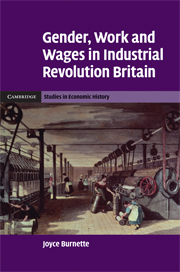Book contents
- Frontmatter
- Contents
- List of figures
- List of tables
- Preface
- Introduction
- 1 Women's occupations
- 2 Women's wages
- 3 Explaining occupational sorting
- 4 Testing for occupational barriers in agriculture
- 5 Barriers to women's employment
- 6 Occupational barriers in self-employment
- 7 Women's labor force participation
- 8 Conclusion
- Appendix to Chapter 3
- Appendix to Chapter 4
- Bibliography
- Index
4 - Testing for occupational barriers in agriculture
Published online by Cambridge University Press: 07 August 2009
- Frontmatter
- Contents
- List of figures
- List of tables
- Preface
- Introduction
- 1 Women's occupations
- 2 Women's wages
- 3 Explaining occupational sorting
- 4 Testing for occupational barriers in agriculture
- 5 Barriers to women's employment
- 6 Occupational barriers in self-employment
- 7 Women's labor force participation
- 8 Conclusion
- Appendix to Chapter 3
- Appendix to Chapter 4
- Bibliography
- Index
Summary
The last chapter presented two models of occupational sorting by strength and argued that, in the more competitive portions of the labor market, the division of labor between the sexes can be explained by comparative advantage. This chapter will present statistical tests for occupational barriers in agriculture. Both discrimination and free markets would imply that men and women worked different jobs. This chapter will attempt to distinguish between those two theories by testing whether the labor market was segmented or integrated. If customary barriers kept women in certain types of work, then changes in the supply of or demand for their labor would not influence the wage or employment of male workers. However, if the division of labor was the result of the sorting models presented in the last chapter, then men and women should be substitutable, and changes in the wages of one sex should affect the labor market opportunities for the other sex.
Having established that sex differences in wages and occupations are not proof of occupational segregation constraints, I will now provide evidence that the agricultural labor market did not have discriminatory occupational constraints. The results in this chapter will show that men and women were hired in an integrated labor market; employers were willing to substitute men and women workers in response to wage changes. As we shall see in later chapters, these results do not apply to the entire labor market. The evidence provided here is for agriculture only.
- Type
- Chapter
- Information
- Gender, Work and Wages in Industrial Revolution Britain , pp. 186 - 220Publisher: Cambridge University PressPrint publication year: 2008



